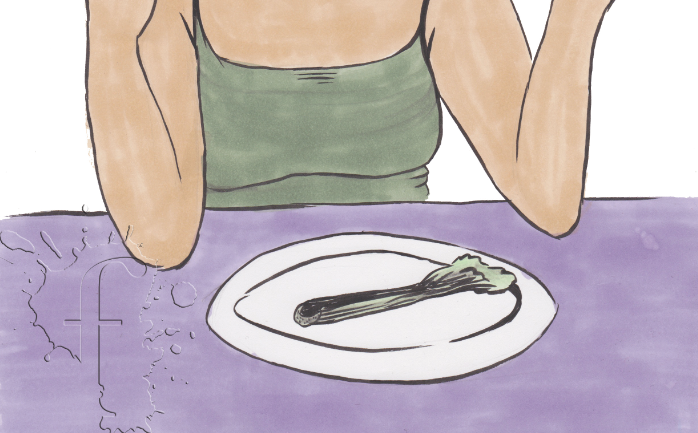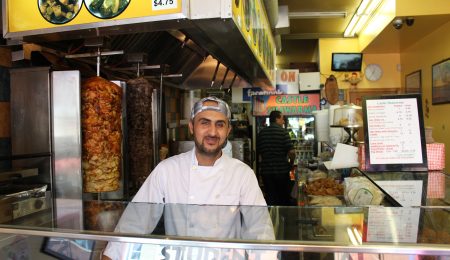The scoop on diets, from the wild to the wonderful
Illustration by Kelsey Shore
IT’S OFTEN SAID that your weight and body shape is determined 10 per cent by genetics, 20 per cent by working out, and a whopping 70 per cent by what you eat. Here, the Fulcrum serves up some diets and the philosophy behind them. From the outlandish to the trendy, see what’s been making a buzz lately in the world of food and fitness.
Paleolithic eating
Also referred to as the Paleo diet, this way of eating focuses on the foods that our hunting-and-gathering ancestors used to consume, before the development of agriculture. The diet is based on the concept that evolution hasn’t caught up to human innovation in agriculture, and our bodies are still meant to eat the foods our ancestors did. So what are you allowed to eat? Whole foods, but without grains, dairy, beans, legumes, sugar, or salt. That leaves nuts, fruits, vegetables, eggs, meat, and fish to adorn your plate. Like with any diet that forces you to eliminate entire food groups, the Paleo diet is likely to help you lose weight. It is high in protein and low in sugar and carbs, somewhat similar to the Atkins diet. The emphasis on whole foods is definitely the biggest pro to this diet, but there are a few cons to consider as well. The Paleo diet can be high in saturated fat because of the level of meat consumption. Furthermore, skeptics have argued that the diet is better suited to our ancestors’ highly active lifestyle than to our more sedentary one—those hunters and gatherers had a greater need for fat and protein.
The Paleo diet is a trendy one as of late—popular fitness program CrossFit recommends eating Paleo as the best accompaniment to its strength and conditioning plan. On the other hand, many nutritionists would tell you everything is okay in moderation, and cutting out entire food groups like carbs and dairy might not be your best bet.
—Ali Schwabe
Nothing but sunshine: the breatharian diet
Based on the belief that our bodies are self-sustaining, an ideal breatharian does exactly what the name suggests—breathes air. According to this diet, a person’s DNA can be activated by being conscious of the mind, body, and all seven chakras. The active DNA becomes magnetic and draws in white light to separate the chakras into colours. These coloured lights are the nutrients the body needs to survive. Sound sketchy? Oh, there’s more. According to breatharian ideology, any physical food that is ingested is damaging, and a hunger for food shows emotional and psychological weakness. Breatharianism is linked loosely with Hinduism’s prana (which means life force) theory; solid foods and liquids become unnecessary because all a breatharian needs is to tap into the life force. Although there is no way of telling how many breatharians, and more importantly failed breatharians, are out there, it is safe to say that this diet is not for everyone—or anyone, for that matter. While the Fulcrum doesn’t recommend sticking to this style of eating, it does sound easy: all you have to do is sit out in the sun and breathe. The only problem? Say adios to your favourite foods… and hello to hunger.
—Tess Kim
Subway, eat fresh
It all started in 1998 with a 425-pound, 6-foot-2-inch Indiana University student named Jared Fogle. Before spring break of his third year, Fogle created an unconventional diet regimen for himself: he would walk to the nearest Subway and order himself any sandwich from Subway’s seven low-fat sandwich options, twice a day. Every day. For 11 months. While most would cringe at the thought of subsisting exclusively on subs for almost a year, Jared slimmed down to an astounding 180 pounds. He later became a spokesperson for Subway—a wise, wise move on Subway’s part. His diet was also featured in Men’s Health magazine, under the title “Crazy Diets that Work”; and it did work. At the end of the day, Fogle’s Subway diet was fast and cheap. He was only consuming around 980 calories a day and he had managed to incorporate physical exercise into his lifestyle by walking twice a day to get his food. However, any potential Subway dieters should be warned—a diet that lacks in variety and significant intake of fruits and vegetables for prolonged periods of time can lead to nutrient deficiencies. In short, the Subway diet makes for an interesting story, but your body may not be so interested.
—Tess Kim
Flexitarianism: all the choices
As practitioners of one of the more looked-down-upon diets, flexitarians are people who survive off a vegetarian diet, kind of. This diet is followed by many who strive towards vegetarianism but still want the benefits of occasional meat consumption. This is a diet grounded in choice—the choice to indulge in the occasional turkey sandwich or meatball. Flexitarianism is also an umbrella term of sorts: one can be a pollotarian (a vegetarian who eats poultry), a pescetarian (a vegetarian who eats seafood), a macrobiotic dieter (a raw vegan who eats fish), or any one of a number of different pollo-pesce-macro combinations. To some ardent vegetarians or true-blue vegans, this diet may seem like cheating. In reality, it can be an easier, more realistic way of adhering to a vegetarian lifestyle for people who just want to dip their toe into the proverbial meatless pool. It’s the commitment-phobe’s answer to diets, if you will. There are loads of benefits that come with flexitarianism, too: studies have found that people who subsist off a mainly vegetarian diet live 3.6 years longer than their carnivorous counterparts. For those of you who want to slim down, listen to this—flexitarians, vegetarians, and vegans weigh on average 15 per cent less than their meat-eating friends. Not a bad diet to try if you don’t want to say goodbye to bacon forever.
—Tess Kim





